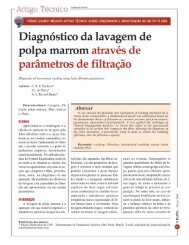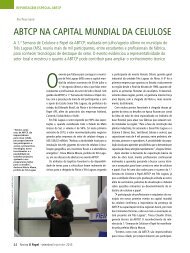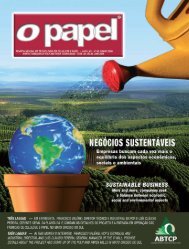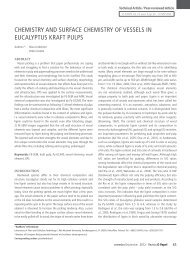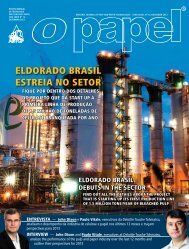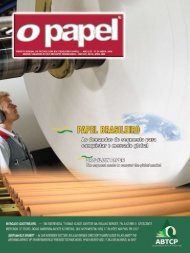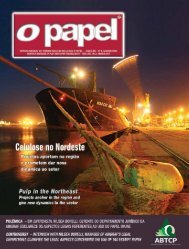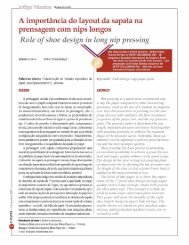Create successful ePaper yourself
Turn your PDF publications into a flip-book with our unique Google optimized e-Paper software.
Primary sludge from pulp and paper mills as a potentialraw material to produce value-added products /UTILIZAÇÃO DE LAMAS PRIMÁRIAS DA INDÚSTRIA DE CELULOSE EPAPEL COMO MATÉRIA-PRIMA PARA OBTENÇÃO DE PRODUTOS DEVALOR AGREGADOStudies on the cellulose fibre surfaces modified withxylan derivatives / ESTUDOS SOBRE SUPERFÍCIES DA FIBRA DECELULOSE MODIFICADAS COM DERIVADOS DE XILANOEvaluation/Avaliação: 9,25Evaluation/Avaliação: 9,32Authors/Autores: Cátia V. T. Mendes 1Jorge M. S. Rocha 1M. Graça V. S. Carvalho 1Author´s references/Referências dos autores:1. CIEPQPF, Department of Chemical Engineering, Faculty of Sciencesand Technology, University of Coimbra, PortugalABSTRACT/RESUMOPrimary sludge from pulp and paper mills is a solid residue consistingof cellulosic fibres - lost during the pulping process - and ash. Generallydischarged in landfills or disposed of by composting, this lignocellulosicwaste can be valorized and used as feedstock to produce valueaddedproducts. The aim of this research is to study and optimize thebiochemical processes to convert the primary sludge from pulp and papermills to fermentable sugars to be used as substrate for a fermentationprocess, to produce bioethanol as a case study. The primary sludge wassubjected to enzymatic hydrolysis to convert the resistant cellulosicfibres to monomeric sugars. However, the enzymatic reaction wasnegatively interfered by the presence of ash in the primary sludge, mainlyCaCO 3, which provides primary sludge a pH value (7-9) higher than theoptimum pH of the enzymatic reaction (5.0). To enhance the efficiencyof the enzymatic hydrolysis in a separate hydrolysis and fermentationprocess (SHF), a pretreatment was applied to the primary sludge. CaCO 3neutralization with acid enabled in the further step high conversion yieldsof the carbohydrates to monosaccharides (up to 88%). The enzymatichydrolysates were used in fermentation processes with Saccharomycescerevisiae and Pichia stipitis to produce ethanol. Both yeasts showedsimilar fermentation profiles. Ethanol yields up to 96% of the theoreticalmaximum (0.51 gEtOH gglucose -1 ) were achieved on the basis of totalmonosaccharides consumed. Bioethanol was produced with rates upto 0.24 gEtOH L -1 h -1 . Nevertheless, the treatment of primary sludgewith acid releases CO 2, a negative environmental impact. Alternativemethodologies are under study to substitute the acid neutralization ofCaCO 3, such as water-based techniques with distilled or carbonatedwater. Primary sludge was washed with water for serial washing cycles (1,2, 3, 6, 12 and 24), with CaCO 3being effectively removed after 6 washingcycles. Primary sludge was also washed with carbonated water fordifferent time periods. The increase of washing time induced the decreaseof CaCO 3residual content in the treated primary sludge.Authors/Autores: Beatriz Vega 1,3Katrin Petzold-Welcke 2,3Pedro Fardim 1,3Thomas Heinze 1,2,3Author´s references/Referências dos autores:1. Laboratory of Fibre and Cellulose Technology, Åbo Akademi University.Finland2. Center of Excellence for Polysaccharide Research at Institute ofOrganic Chemistry and Macromolecular Chemistry, Friedrich SchillerUniversity of Jena. Germany3. Members of the European Polysaccharide Network of Excellence(EPNOE) - www.epnoe.euABSTRACT/RESUMOXylan was isolated from birch wood chips by using pressurized hotwater extraction (PHWE). The extracted xylan was chemically modifiedyielding three different xylan derivatives (XDs): xylan sulfate (XS),carboxymethyl xylan (CMX) and xylan-4-[N,N,N-trimethylammonium]butyrate chloride (XTMAB). The structure and molecular weight ofXDs was determined by using NMR spectroscopy and size exclusionchromatography (SEC). The potential utilization of xylan polyelectrolytesfor modifying fibre surfaces was assessed by sorption experimentsusing bleached pine kraft pulp as substrate. Polyelectrolyte titrationmethod was chosen for estimating the amount of sorbed XDs onto thefibres. The cationic xylan derivative XTMAB had a strong interactionwith fibres while the anionic derivatives did not show any sorption.X-ray photoelectron spectroscopy (XPS) and time of flight secondaryion mass spectrometry (ToF-SIMS) were selected as advanced surfaceanalyses for studying the amount of surface anionic groups and thesurface distribution of the XTMAB. XPS and polyelectrolyte titrationresults suggested that the XTMAB is sorbed onto the fibre surfaces.ToF-SIMS imaging showed that XTMAB was evenly distributed on fibresurfaces.novembro/November <strong>2012</strong> - <strong>Revista</strong> O <strong>Papel</strong>49



